ACCT20075: Auditing and Ethics Report - Company Analysis and Review
VerifiedAdded on 2023/06/08
|15
|2949
|483
Report
AI Summary
This report provides a comprehensive analysis of the auditing procedures applied to Woodside Petroleum Limited (WPL). It begins by examining materiality determination, considering both qualitative and quantitative aspects, and calculating planning materiality based on WPL's 2017 financial data. The report then reviews draft notes and disclosures, highlighting significant items like leases, contingent liabilities, and dividends. A detailed financial statement analytical review follows, assessing liquidity, profitability, asset management, leverage, and valuation ratios from 2014 to 2017. The analysis includes an examination of cash flow, focusing on operating, investing activities, and non-cash transactions. Finally, the report assesses going concern risk, considering WPL's financial performance and potential impact on its ability to continue as a viable business. The report concludes with a review of the auditor's report.
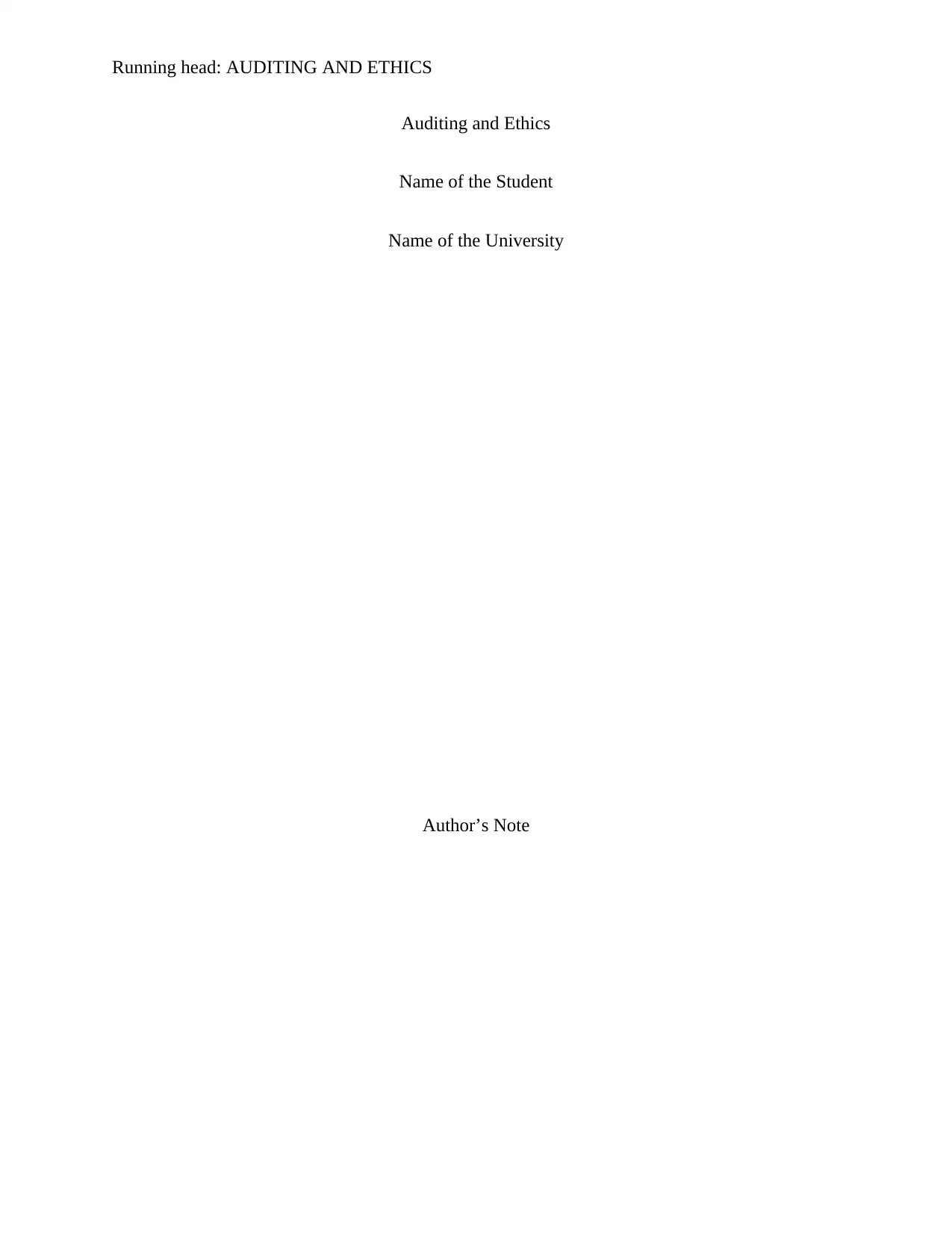
Running head: AUDITING AND ETHICS
Auditing and Ethics
Name of the Student
Name of the University
Author’s Note
Auditing and Ethics
Name of the Student
Name of the University
Author’s Note
Paraphrase This Document
Need a fresh take? Get an instant paraphrase of this document with our AI Paraphraser
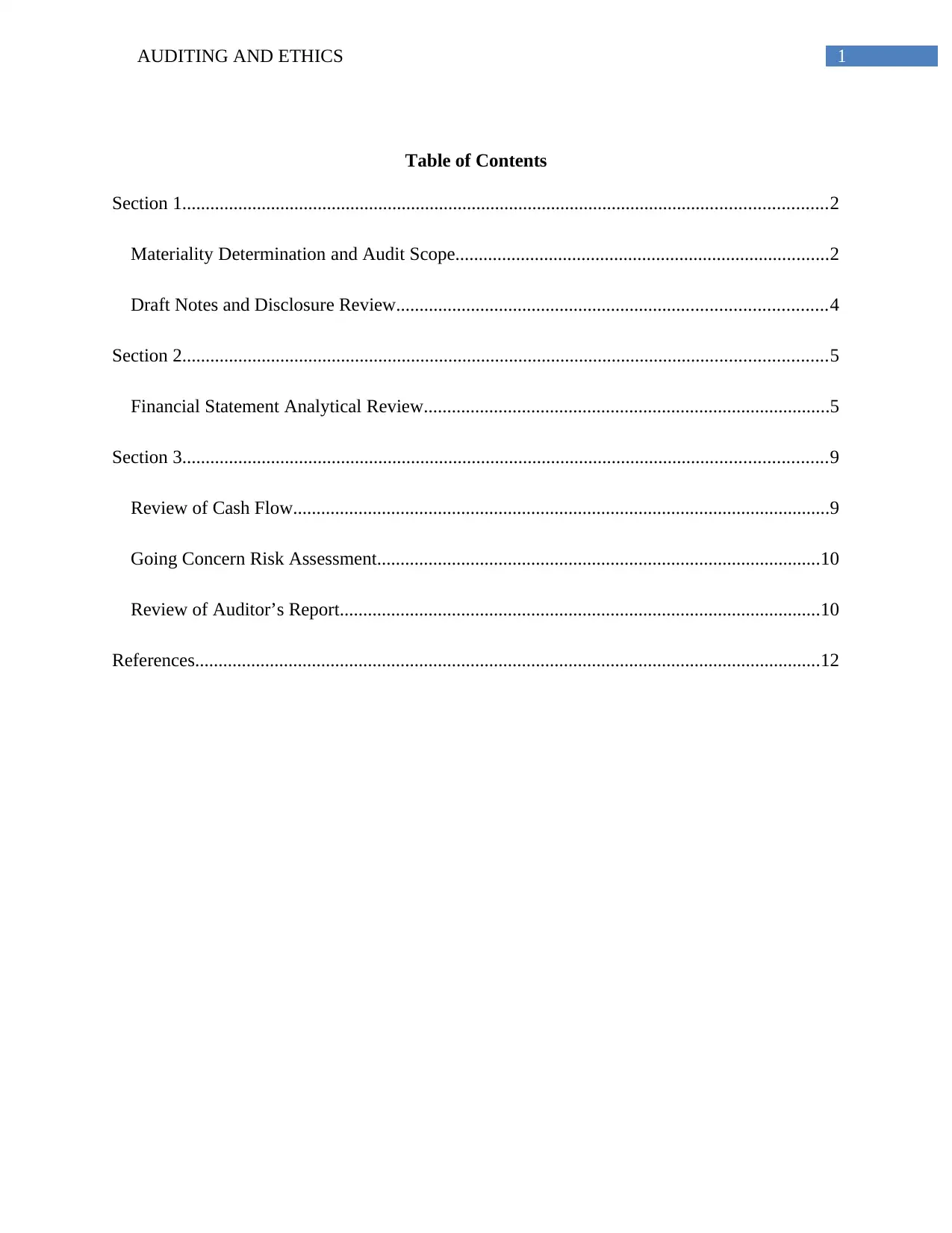
1AUDITING AND ETHICS
Table of Contents
Section 1..........................................................................................................................................2
Materiality Determination and Audit Scope................................................................................2
Draft Notes and Disclosure Review............................................................................................4
Section 2..........................................................................................................................................5
Financial Statement Analytical Review.......................................................................................5
Section 3..........................................................................................................................................9
Review of Cash Flow...................................................................................................................9
Going Concern Risk Assessment...............................................................................................10
Review of Auditor’s Report.......................................................................................................10
References......................................................................................................................................12
Table of Contents
Section 1..........................................................................................................................................2
Materiality Determination and Audit Scope................................................................................2
Draft Notes and Disclosure Review............................................................................................4
Section 2..........................................................................................................................................5
Financial Statement Analytical Review.......................................................................................5
Section 3..........................................................................................................................................9
Review of Cash Flow...................................................................................................................9
Going Concern Risk Assessment...............................................................................................10
Review of Auditor’s Report.......................................................................................................10
References......................................................................................................................................12
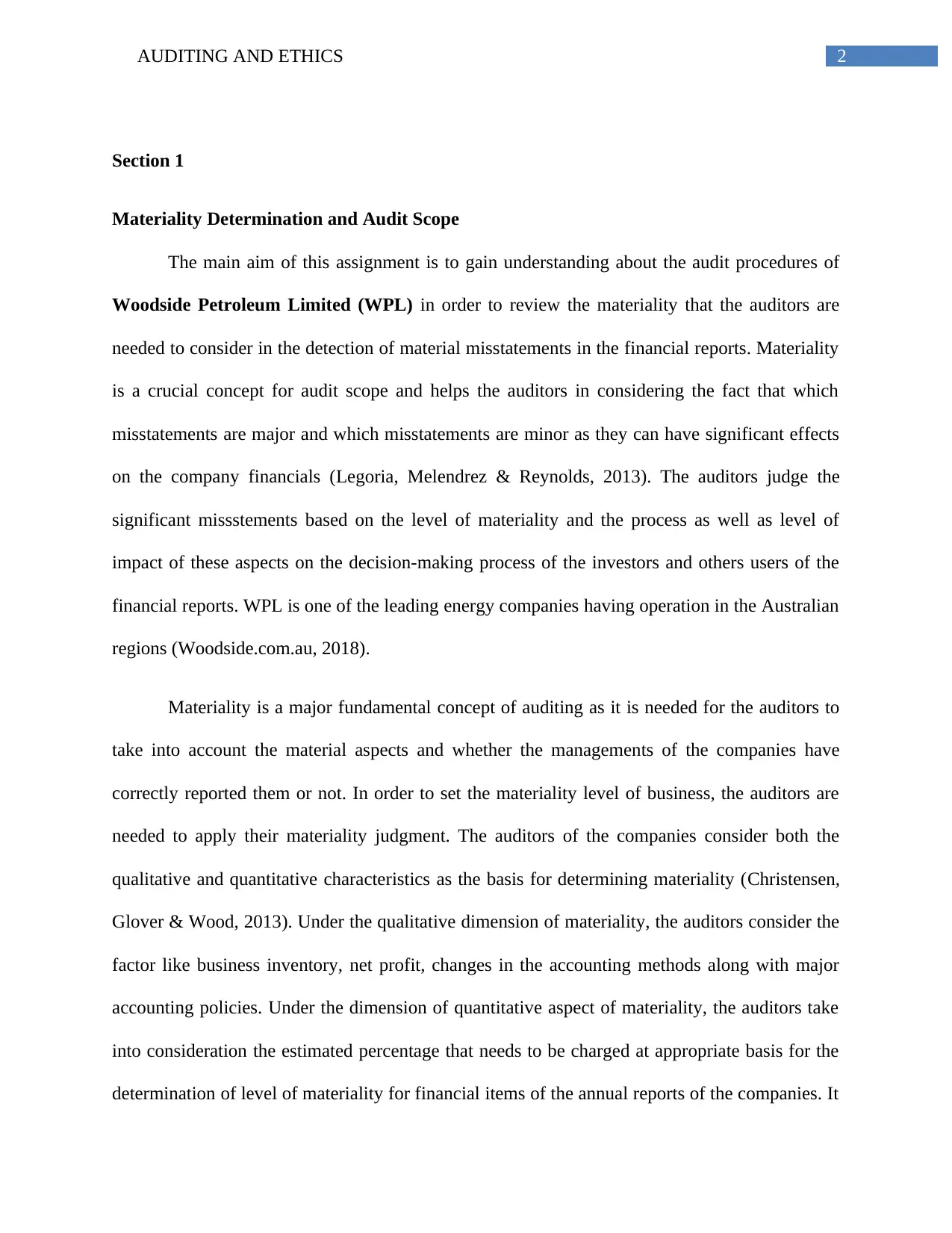
2AUDITING AND ETHICS
Section 1
Materiality Determination and Audit Scope
The main aim of this assignment is to gain understanding about the audit procedures of
Woodside Petroleum Limited (WPL) in order to review the materiality that the auditors are
needed to consider in the detection of material misstatements in the financial reports. Materiality
is a crucial concept for audit scope and helps the auditors in considering the fact that which
misstatements are major and which misstatements are minor as they can have significant effects
on the company financials (Legoria, Melendrez & Reynolds, 2013). The auditors judge the
significant missstements based on the level of materiality and the process as well as level of
impact of these aspects on the decision-making process of the investors and others users of the
financial reports. WPL is one of the leading energy companies having operation in the Australian
regions (Woodside.com.au, 2018).
Materiality is a major fundamental concept of auditing as it is needed for the auditors to
take into account the material aspects and whether the managements of the companies have
correctly reported them or not. In order to set the materiality level of business, the auditors are
needed to apply their materiality judgment. The auditors of the companies consider both the
qualitative and quantitative characteristics as the basis for determining materiality (Christensen,
Glover & Wood, 2013). Under the qualitative dimension of materiality, the auditors consider the
factor like business inventory, net profit, changes in the accounting methods along with major
accounting policies. Under the dimension of quantitative aspect of materiality, the auditors take
into consideration the estimated percentage that needs to be charged at appropriate basis for the
determination of level of materiality for financial items of the annual reports of the companies. It
Section 1
Materiality Determination and Audit Scope
The main aim of this assignment is to gain understanding about the audit procedures of
Woodside Petroleum Limited (WPL) in order to review the materiality that the auditors are
needed to consider in the detection of material misstatements in the financial reports. Materiality
is a crucial concept for audit scope and helps the auditors in considering the fact that which
misstatements are major and which misstatements are minor as they can have significant effects
on the company financials (Legoria, Melendrez & Reynolds, 2013). The auditors judge the
significant missstements based on the level of materiality and the process as well as level of
impact of these aspects on the decision-making process of the investors and others users of the
financial reports. WPL is one of the leading energy companies having operation in the Australian
regions (Woodside.com.au, 2018).
Materiality is a major fundamental concept of auditing as it is needed for the auditors to
take into account the material aspects and whether the managements of the companies have
correctly reported them or not. In order to set the materiality level of business, the auditors are
needed to apply their materiality judgment. The auditors of the companies consider both the
qualitative and quantitative characteristics as the basis for determining materiality (Christensen,
Glover & Wood, 2013). Under the qualitative dimension of materiality, the auditors consider the
factor like business inventory, net profit, changes in the accounting methods along with major
accounting policies. Under the dimension of quantitative aspect of materiality, the auditors take
into consideration the estimated percentage that needs to be charged at appropriate basis for the
determination of level of materiality for financial items of the annual reports of the companies. It
⊘ This is a preview!⊘
Do you want full access?
Subscribe today to unlock all pages.

Trusted by 1+ million students worldwide
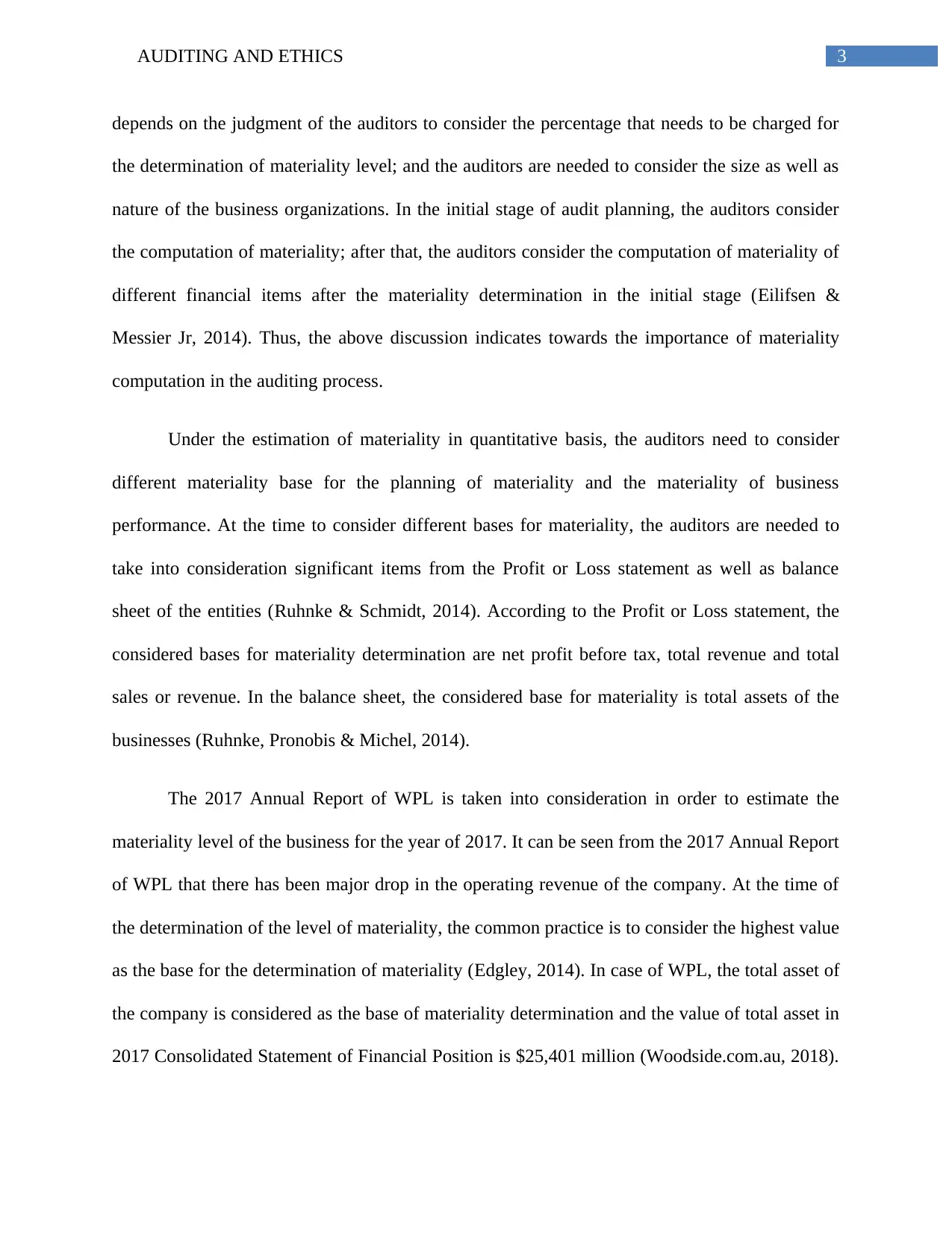
3AUDITING AND ETHICS
depends on the judgment of the auditors to consider the percentage that needs to be charged for
the determination of materiality level; and the auditors are needed to consider the size as well as
nature of the business organizations. In the initial stage of audit planning, the auditors consider
the computation of materiality; after that, the auditors consider the computation of materiality of
different financial items after the materiality determination in the initial stage (Eilifsen &
Messier Jr, 2014). Thus, the above discussion indicates towards the importance of materiality
computation in the auditing process.
Under the estimation of materiality in quantitative basis, the auditors need to consider
different materiality base for the planning of materiality and the materiality of business
performance. At the time to consider different bases for materiality, the auditors are needed to
take into consideration significant items from the Profit or Loss statement as well as balance
sheet of the entities (Ruhnke & Schmidt, 2014). According to the Profit or Loss statement, the
considered bases for materiality determination are net profit before tax, total revenue and total
sales or revenue. In the balance sheet, the considered base for materiality is total assets of the
businesses (Ruhnke, Pronobis & Michel, 2014).
The 2017 Annual Report of WPL is taken into consideration in order to estimate the
materiality level of the business for the year of 2017. It can be seen from the 2017 Annual Report
of WPL that there has been major drop in the operating revenue of the company. At the time of
the determination of the level of materiality, the common practice is to consider the highest value
as the base for the determination of materiality (Edgley, 2014). In case of WPL, the total asset of
the company is considered as the base of materiality determination and the value of total asset in
2017 Consolidated Statement of Financial Position is $25,401 million (Woodside.com.au, 2018).
depends on the judgment of the auditors to consider the percentage that needs to be charged for
the determination of materiality level; and the auditors are needed to consider the size as well as
nature of the business organizations. In the initial stage of audit planning, the auditors consider
the computation of materiality; after that, the auditors consider the computation of materiality of
different financial items after the materiality determination in the initial stage (Eilifsen &
Messier Jr, 2014). Thus, the above discussion indicates towards the importance of materiality
computation in the auditing process.
Under the estimation of materiality in quantitative basis, the auditors need to consider
different materiality base for the planning of materiality and the materiality of business
performance. At the time to consider different bases for materiality, the auditors are needed to
take into consideration significant items from the Profit or Loss statement as well as balance
sheet of the entities (Ruhnke & Schmidt, 2014). According to the Profit or Loss statement, the
considered bases for materiality determination are net profit before tax, total revenue and total
sales or revenue. In the balance sheet, the considered base for materiality is total assets of the
businesses (Ruhnke, Pronobis & Michel, 2014).
The 2017 Annual Report of WPL is taken into consideration in order to estimate the
materiality level of the business for the year of 2017. It can be seen from the 2017 Annual Report
of WPL that there has been major drop in the operating revenue of the company. At the time of
the determination of the level of materiality, the common practice is to consider the highest value
as the base for the determination of materiality (Edgley, 2014). In case of WPL, the total asset of
the company is considered as the base of materiality determination and the value of total asset in
2017 Consolidated Statement of Financial Position is $25,401 million (Woodside.com.au, 2018).
Paraphrase This Document
Need a fresh take? Get an instant paraphrase of this document with our AI Paraphraser
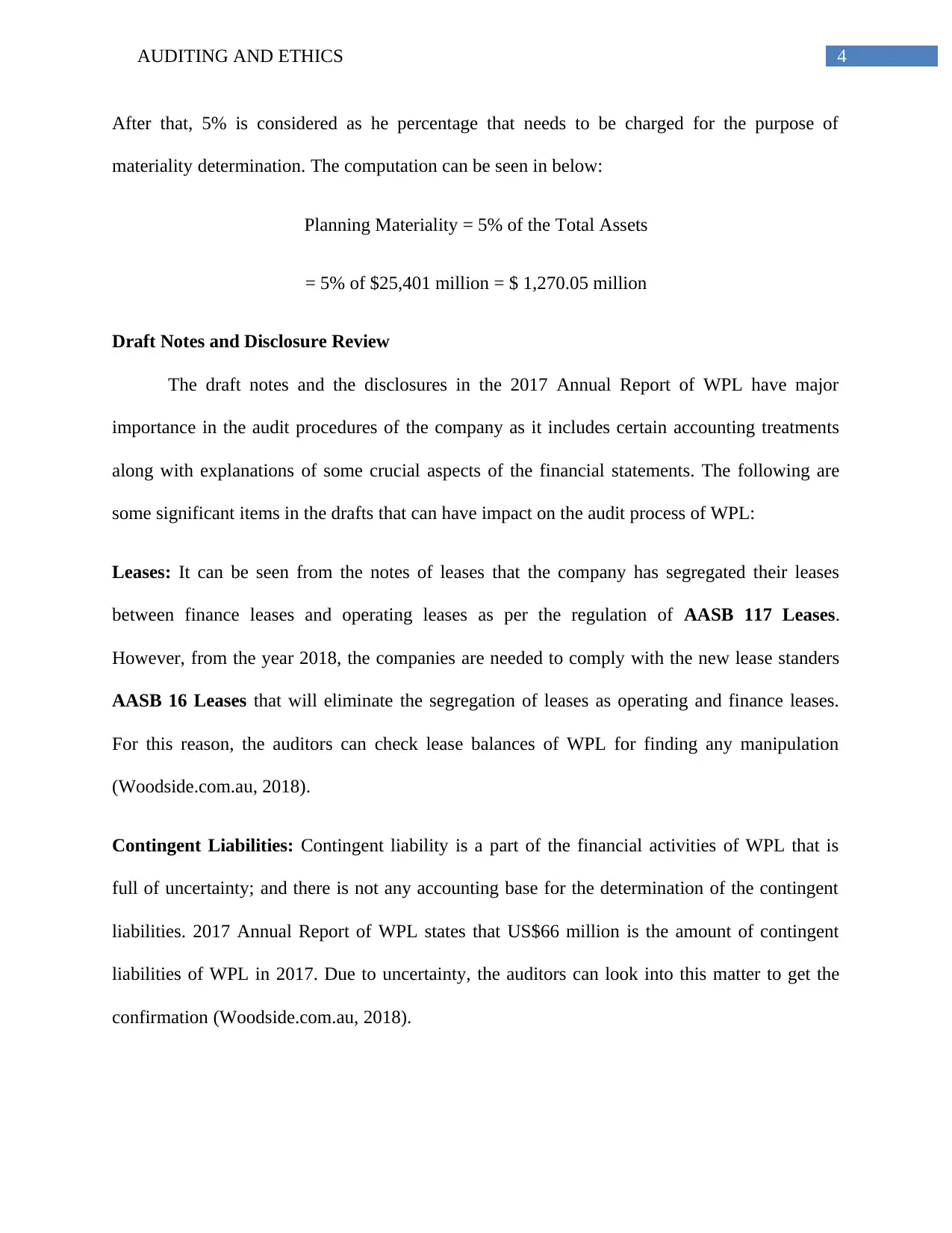
4AUDITING AND ETHICS
After that, 5% is considered as he percentage that needs to be charged for the purpose of
materiality determination. The computation can be seen in below:
Planning Materiality = 5% of the Total Assets
= 5% of $25,401 million = $ 1,270.05 million
Draft Notes and Disclosure Review
The draft notes and the disclosures in the 2017 Annual Report of WPL have major
importance in the audit procedures of the company as it includes certain accounting treatments
along with explanations of some crucial aspects of the financial statements. The following are
some significant items in the drafts that can have impact on the audit process of WPL:
Leases: It can be seen from the notes of leases that the company has segregated their leases
between finance leases and operating leases as per the regulation of AASB 117 Leases.
However, from the year 2018, the companies are needed to comply with the new lease standers
AASB 16 Leases that will eliminate the segregation of leases as operating and finance leases.
For this reason, the auditors can check lease balances of WPL for finding any manipulation
(Woodside.com.au, 2018).
Contingent Liabilities: Contingent liability is a part of the financial activities of WPL that is
full of uncertainty; and there is not any accounting base for the determination of the contingent
liabilities. 2017 Annual Report of WPL states that US$66 million is the amount of contingent
liabilities of WPL in 2017. Due to uncertainty, the auditors can look into this matter to get the
confirmation (Woodside.com.au, 2018).
After that, 5% is considered as he percentage that needs to be charged for the purpose of
materiality determination. The computation can be seen in below:
Planning Materiality = 5% of the Total Assets
= 5% of $25,401 million = $ 1,270.05 million
Draft Notes and Disclosure Review
The draft notes and the disclosures in the 2017 Annual Report of WPL have major
importance in the audit procedures of the company as it includes certain accounting treatments
along with explanations of some crucial aspects of the financial statements. The following are
some significant items in the drafts that can have impact on the audit process of WPL:
Leases: It can be seen from the notes of leases that the company has segregated their leases
between finance leases and operating leases as per the regulation of AASB 117 Leases.
However, from the year 2018, the companies are needed to comply with the new lease standers
AASB 16 Leases that will eliminate the segregation of leases as operating and finance leases.
For this reason, the auditors can check lease balances of WPL for finding any manipulation
(Woodside.com.au, 2018).
Contingent Liabilities: Contingent liability is a part of the financial activities of WPL that is
full of uncertainty; and there is not any accounting base for the determination of the contingent
liabilities. 2017 Annual Report of WPL states that US$66 million is the amount of contingent
liabilities of WPL in 2017. Due to uncertainty, the auditors can look into this matter to get the
confirmation (Woodside.com.au, 2018).
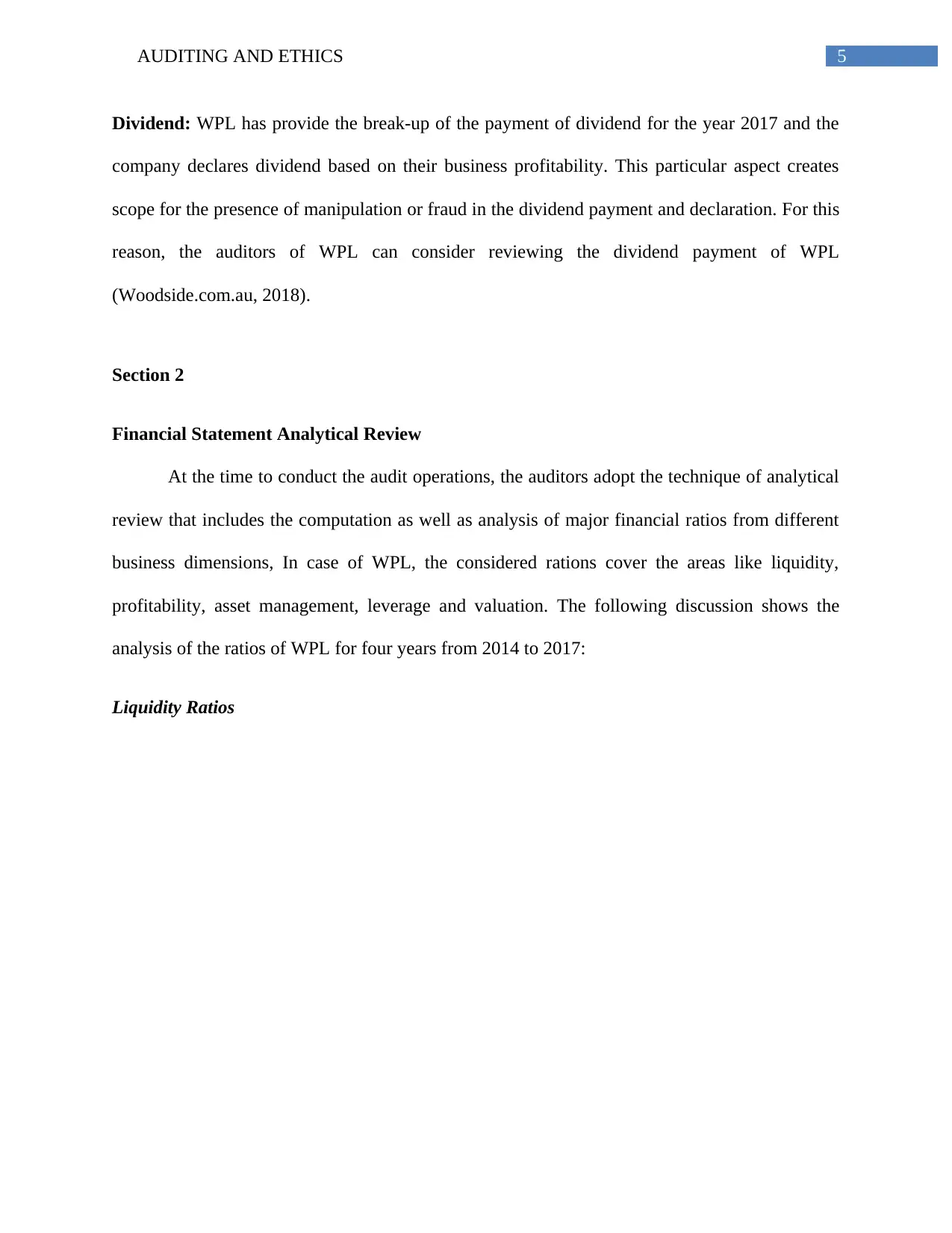
5AUDITING AND ETHICS
Dividend: WPL has provide the break-up of the payment of dividend for the year 2017 and the
company declares dividend based on their business profitability. This particular aspect creates
scope for the presence of manipulation or fraud in the dividend payment and declaration. For this
reason, the auditors of WPL can consider reviewing the dividend payment of WPL
(Woodside.com.au, 2018).
Section 2
Financial Statement Analytical Review
At the time to conduct the audit operations, the auditors adopt the technique of analytical
review that includes the computation as well as analysis of major financial ratios from different
business dimensions, In case of WPL, the considered rations cover the areas like liquidity,
profitability, asset management, leverage and valuation. The following discussion shows the
analysis of the ratios of WPL for four years from 2014 to 2017:
Liquidity Ratios
Dividend: WPL has provide the break-up of the payment of dividend for the year 2017 and the
company declares dividend based on their business profitability. This particular aspect creates
scope for the presence of manipulation or fraud in the dividend payment and declaration. For this
reason, the auditors of WPL can consider reviewing the dividend payment of WPL
(Woodside.com.au, 2018).
Section 2
Financial Statement Analytical Review
At the time to conduct the audit operations, the auditors adopt the technique of analytical
review that includes the computation as well as analysis of major financial ratios from different
business dimensions, In case of WPL, the considered rations cover the areas like liquidity,
profitability, asset management, leverage and valuation. The following discussion shows the
analysis of the ratios of WPL for four years from 2014 to 2017:
Liquidity Ratios
⊘ This is a preview!⊘
Do you want full access?
Subscribe today to unlock all pages.

Trusted by 1+ million students worldwide
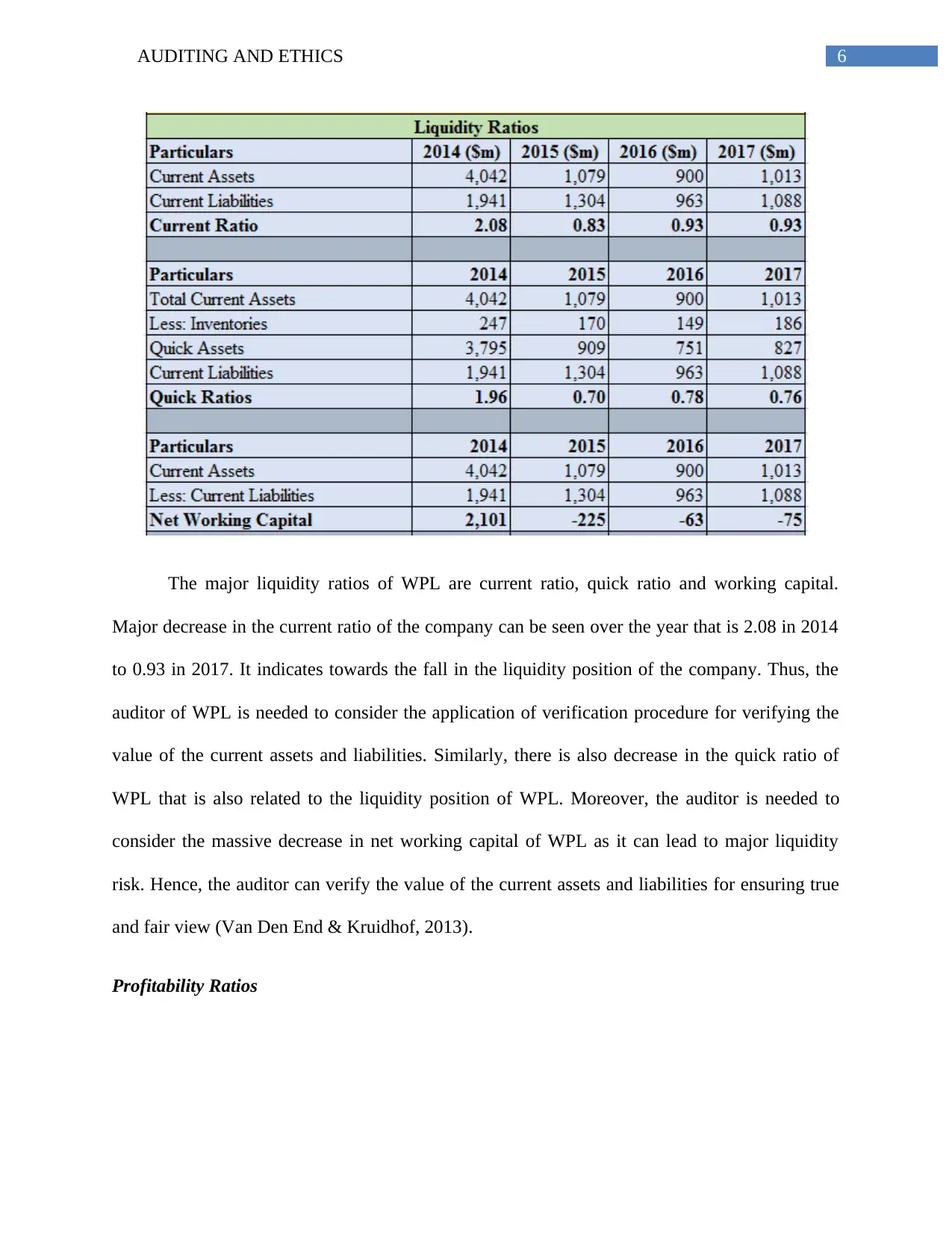
6AUDITING AND ETHICS
The major liquidity ratios of WPL are current ratio, quick ratio and working capital.
Major decrease in the current ratio of the company can be seen over the year that is 2.08 in 2014
to 0.93 in 2017. It indicates towards the fall in the liquidity position of the company. Thus, the
auditor of WPL is needed to consider the application of verification procedure for verifying the
value of the current assets and liabilities. Similarly, there is also decrease in the quick ratio of
WPL that is also related to the liquidity position of WPL. Moreover, the auditor is needed to
consider the massive decrease in net working capital of WPL as it can lead to major liquidity
risk. Hence, the auditor can verify the value of the current assets and liabilities for ensuring true
and fair view (Van Den End & Kruidhof, 2013).
Profitability Ratios
The major liquidity ratios of WPL are current ratio, quick ratio and working capital.
Major decrease in the current ratio of the company can be seen over the year that is 2.08 in 2014
to 0.93 in 2017. It indicates towards the fall in the liquidity position of the company. Thus, the
auditor of WPL is needed to consider the application of verification procedure for verifying the
value of the current assets and liabilities. Similarly, there is also decrease in the quick ratio of
WPL that is also related to the liquidity position of WPL. Moreover, the auditor is needed to
consider the massive decrease in net working capital of WPL as it can lead to major liquidity
risk. Hence, the auditor can verify the value of the current assets and liabilities for ensuring true
and fair view (Van Den End & Kruidhof, 2013).
Profitability Ratios
Paraphrase This Document
Need a fresh take? Get an instant paraphrase of this document with our AI Paraphraser

7AUDITING AND ETHICS
The above table shows that there is decrease in both the gross profit margin and net profit
margin from 2014 to 2017. The main reason or the decrease in these profit margins is the
decrease in the revenue of WPL and the management of WPL does not have control on the
expenses. Return on assets and return on equity are the indicators of financial performance and
both these ratios registered drop in 2017 as compared to 2014. Decrease in revenue and profit
can be the reason of this. For this reason, the auditor needs to consider checking both the cash
and credit sales figures in order to ensure that the profit is not understated. After that, the auditor
is needed to consider applying the vouching procedure for checking the viability of expenses.
Moreover, the auditors can use external confirmation in order to determine the expenses (Ogiela
& Ogiela, 2014).
Asset Management Ratios
The above table shows that there is decrease in both the gross profit margin and net profit
margin from 2014 to 2017. The main reason or the decrease in these profit margins is the
decrease in the revenue of WPL and the management of WPL does not have control on the
expenses. Return on assets and return on equity are the indicators of financial performance and
both these ratios registered drop in 2017 as compared to 2014. Decrease in revenue and profit
can be the reason of this. For this reason, the auditor needs to consider checking both the cash
and credit sales figures in order to ensure that the profit is not understated. After that, the auditor
is needed to consider applying the vouching procedure for checking the viability of expenses.
Moreover, the auditors can use external confirmation in order to determine the expenses (Ogiela
& Ogiela, 2014).
Asset Management Ratios
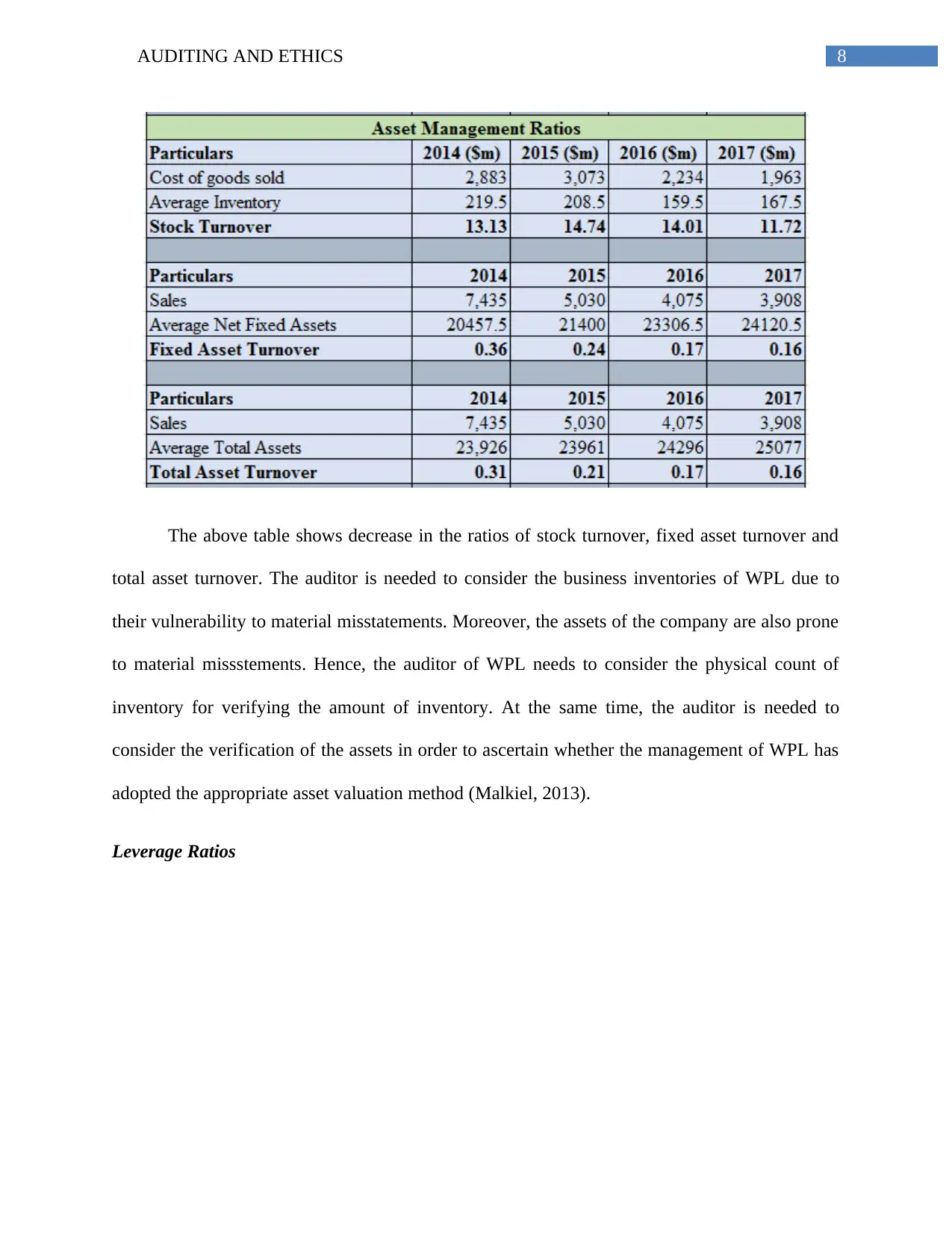
8AUDITING AND ETHICS
The above table shows decrease in the ratios of stock turnover, fixed asset turnover and
total asset turnover. The auditor is needed to consider the business inventories of WPL due to
their vulnerability to material misstatements. Moreover, the assets of the company are also prone
to material missstements. Hence, the auditor of WPL needs to consider the physical count of
inventory for verifying the amount of inventory. At the same time, the auditor is needed to
consider the verification of the assets in order to ascertain whether the management of WPL has
adopted the appropriate asset valuation method (Malkiel, 2013).
Leverage Ratios
The above table shows decrease in the ratios of stock turnover, fixed asset turnover and
total asset turnover. The auditor is needed to consider the business inventories of WPL due to
their vulnerability to material misstatements. Moreover, the assets of the company are also prone
to material missstements. Hence, the auditor of WPL needs to consider the physical count of
inventory for verifying the amount of inventory. At the same time, the auditor is needed to
consider the verification of the assets in order to ascertain whether the management of WPL has
adopted the appropriate asset valuation method (Malkiel, 2013).
Leverage Ratios
⊘ This is a preview!⊘
Do you want full access?
Subscribe today to unlock all pages.

Trusted by 1+ million students worldwide
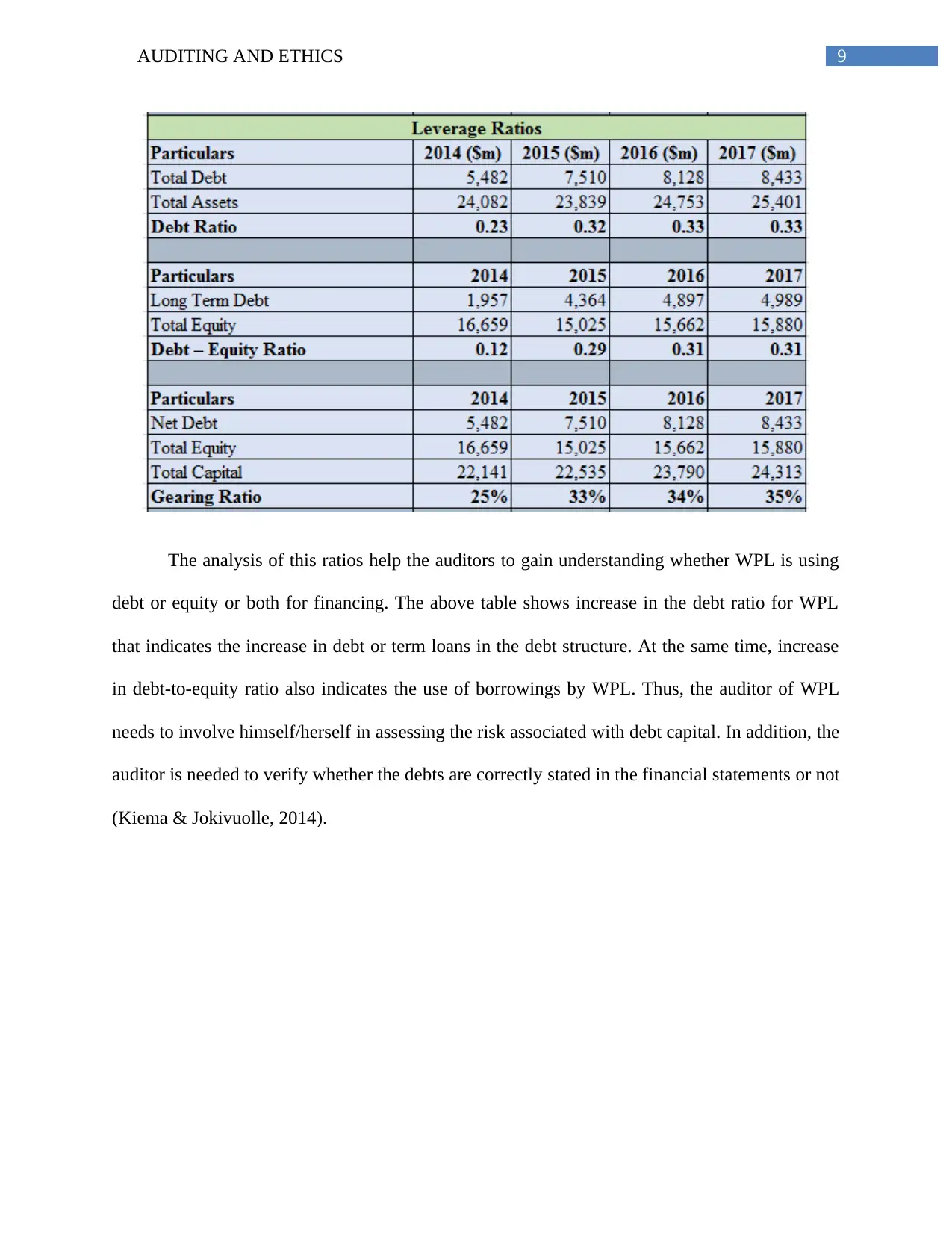
9AUDITING AND ETHICS
The analysis of this ratios help the auditors to gain understanding whether WPL is using
debt or equity or both for financing. The above table shows increase in the debt ratio for WPL
that indicates the increase in debt or term loans in the debt structure. At the same time, increase
in debt-to-equity ratio also indicates the use of borrowings by WPL. Thus, the auditor of WPL
needs to involve himself/herself in assessing the risk associated with debt capital. In addition, the
auditor is needed to verify whether the debts are correctly stated in the financial statements or not
(Kiema & Jokivuolle, 2014).
The analysis of this ratios help the auditors to gain understanding whether WPL is using
debt or equity or both for financing. The above table shows increase in the debt ratio for WPL
that indicates the increase in debt or term loans in the debt structure. At the same time, increase
in debt-to-equity ratio also indicates the use of borrowings by WPL. Thus, the auditor of WPL
needs to involve himself/herself in assessing the risk associated with debt capital. In addition, the
auditor is needed to verify whether the debts are correctly stated in the financial statements or not
(Kiema & Jokivuolle, 2014).
Paraphrase This Document
Need a fresh take? Get an instant paraphrase of this document with our AI Paraphraser
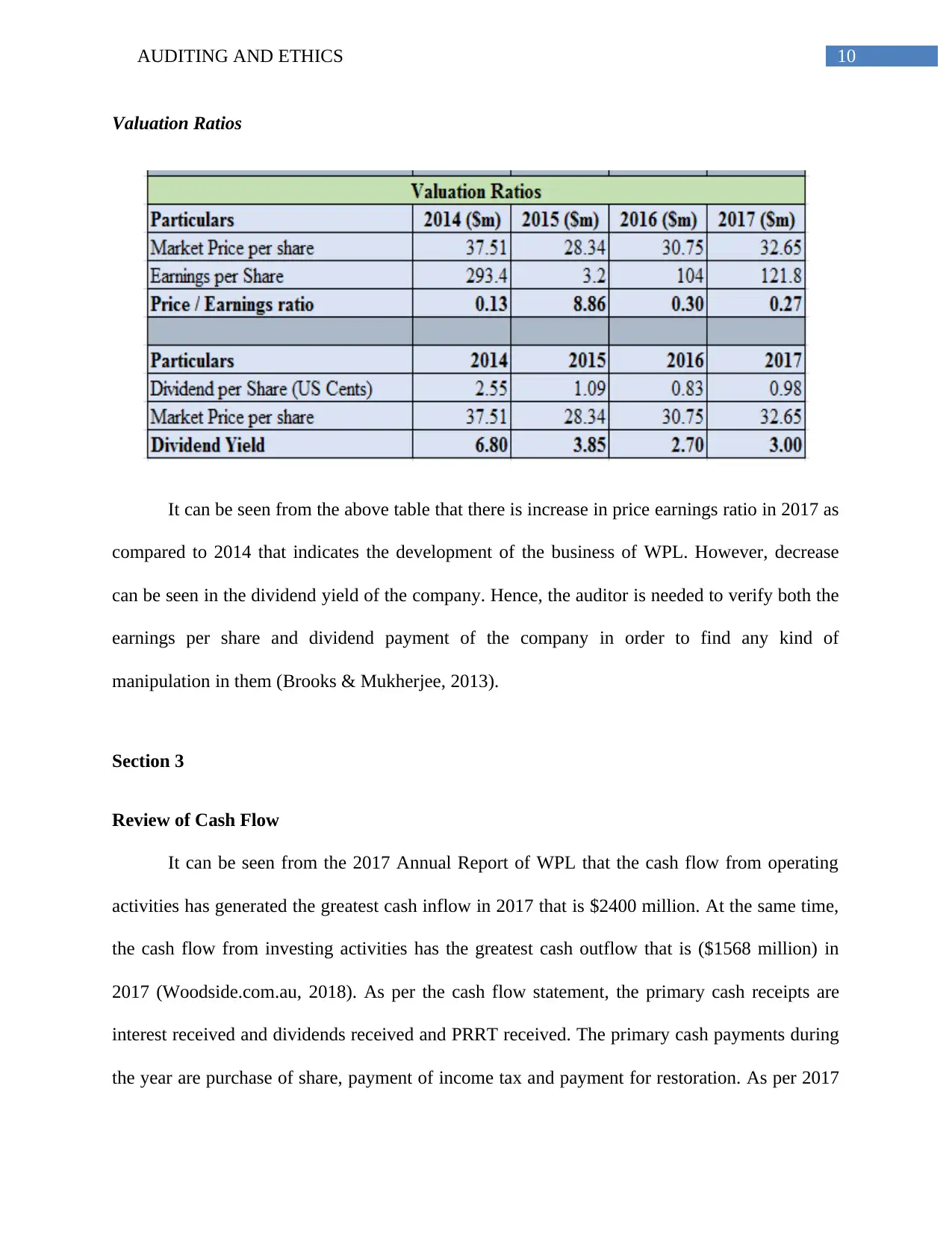
10AUDITING AND ETHICS
Valuation Ratios
It can be seen from the above table that there is increase in price earnings ratio in 2017 as
compared to 2014 that indicates the development of the business of WPL. However, decrease
can be seen in the dividend yield of the company. Hence, the auditor is needed to verify both the
earnings per share and dividend payment of the company in order to find any kind of
manipulation in them (Brooks & Mukherjee, 2013).
Section 3
Review of Cash Flow
It can be seen from the 2017 Annual Report of WPL that the cash flow from operating
activities has generated the greatest cash inflow in 2017 that is $2400 million. At the same time,
the cash flow from investing activities has the greatest cash outflow that is ($1568 million) in
2017 (Woodside.com.au, 2018). As per the cash flow statement, the primary cash receipts are
interest received and dividends received and PRRT received. The primary cash payments during
the year are purchase of share, payment of income tax and payment for restoration. As per 2017
Valuation Ratios
It can be seen from the above table that there is increase in price earnings ratio in 2017 as
compared to 2014 that indicates the development of the business of WPL. However, decrease
can be seen in the dividend yield of the company. Hence, the auditor is needed to verify both the
earnings per share and dividend payment of the company in order to find any kind of
manipulation in them (Brooks & Mukherjee, 2013).
Section 3
Review of Cash Flow
It can be seen from the 2017 Annual Report of WPL that the cash flow from operating
activities has generated the greatest cash inflow in 2017 that is $2400 million. At the same time,
the cash flow from investing activities has the greatest cash outflow that is ($1568 million) in
2017 (Woodside.com.au, 2018). As per the cash flow statement, the primary cash receipts are
interest received and dividends received and PRRT received. The primary cash payments during
the year are purchase of share, payment of income tax and payment for restoration. As per 2017
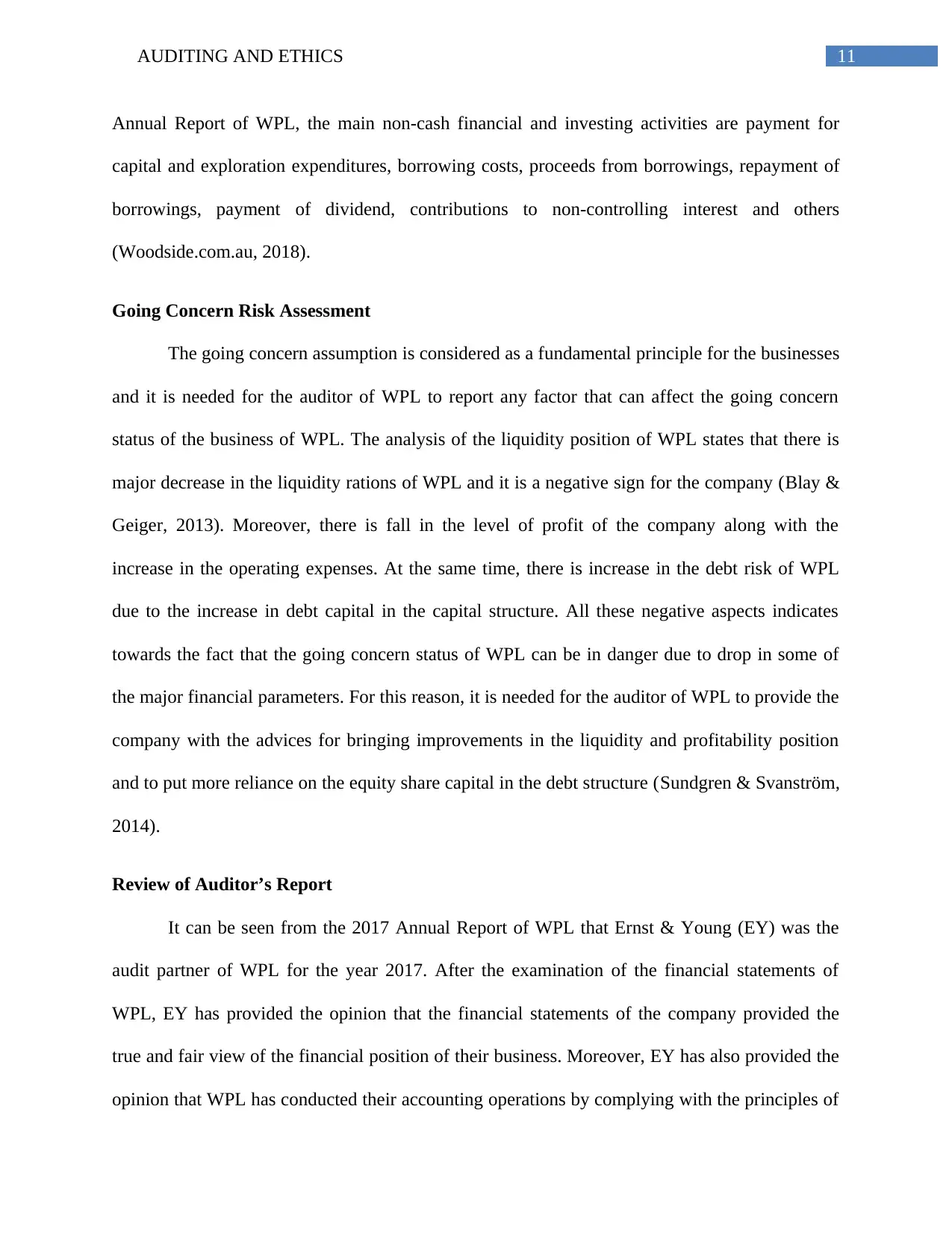
11AUDITING AND ETHICS
Annual Report of WPL, the main non-cash financial and investing activities are payment for
capital and exploration expenditures, borrowing costs, proceeds from borrowings, repayment of
borrowings, payment of dividend, contributions to non-controlling interest and others
(Woodside.com.au, 2018).
Going Concern Risk Assessment
The going concern assumption is considered as a fundamental principle for the businesses
and it is needed for the auditor of WPL to report any factor that can affect the going concern
status of the business of WPL. The analysis of the liquidity position of WPL states that there is
major decrease in the liquidity rations of WPL and it is a negative sign for the company (Blay &
Geiger, 2013). Moreover, there is fall in the level of profit of the company along with the
increase in the operating expenses. At the same time, there is increase in the debt risk of WPL
due to the increase in debt capital in the capital structure. All these negative aspects indicates
towards the fact that the going concern status of WPL can be in danger due to drop in some of
the major financial parameters. For this reason, it is needed for the auditor of WPL to provide the
company with the advices for bringing improvements in the liquidity and profitability position
and to put more reliance on the equity share capital in the debt structure (Sundgren & Svanström,
2014).
Review of Auditor’s Report
It can be seen from the 2017 Annual Report of WPL that Ernst & Young (EY) was the
audit partner of WPL for the year 2017. After the examination of the financial statements of
WPL, EY has provided the opinion that the financial statements of the company provided the
true and fair view of the financial position of their business. Moreover, EY has also provided the
opinion that WPL has conducted their accounting operations by complying with the principles of
Annual Report of WPL, the main non-cash financial and investing activities are payment for
capital and exploration expenditures, borrowing costs, proceeds from borrowings, repayment of
borrowings, payment of dividend, contributions to non-controlling interest and others
(Woodside.com.au, 2018).
Going Concern Risk Assessment
The going concern assumption is considered as a fundamental principle for the businesses
and it is needed for the auditor of WPL to report any factor that can affect the going concern
status of the business of WPL. The analysis of the liquidity position of WPL states that there is
major decrease in the liquidity rations of WPL and it is a negative sign for the company (Blay &
Geiger, 2013). Moreover, there is fall in the level of profit of the company along with the
increase in the operating expenses. At the same time, there is increase in the debt risk of WPL
due to the increase in debt capital in the capital structure. All these negative aspects indicates
towards the fact that the going concern status of WPL can be in danger due to drop in some of
the major financial parameters. For this reason, it is needed for the auditor of WPL to provide the
company with the advices for bringing improvements in the liquidity and profitability position
and to put more reliance on the equity share capital in the debt structure (Sundgren & Svanström,
2014).
Review of Auditor’s Report
It can be seen from the 2017 Annual Report of WPL that Ernst & Young (EY) was the
audit partner of WPL for the year 2017. After the examination of the financial statements of
WPL, EY has provided the opinion that the financial statements of the company provided the
true and fair view of the financial position of their business. Moreover, EY has also provided the
opinion that WPL has conducted their accounting operations by complying with the principles of
⊘ This is a preview!⊘
Do you want full access?
Subscribe today to unlock all pages.

Trusted by 1+ million students worldwide
1 out of 15
Related Documents
Your All-in-One AI-Powered Toolkit for Academic Success.
+13062052269
info@desklib.com
Available 24*7 on WhatsApp / Email
![[object Object]](/_next/static/media/star-bottom.7253800d.svg)
Unlock your academic potential
Copyright © 2020–2025 A2Z Services. All Rights Reserved. Developed and managed by ZUCOL.





